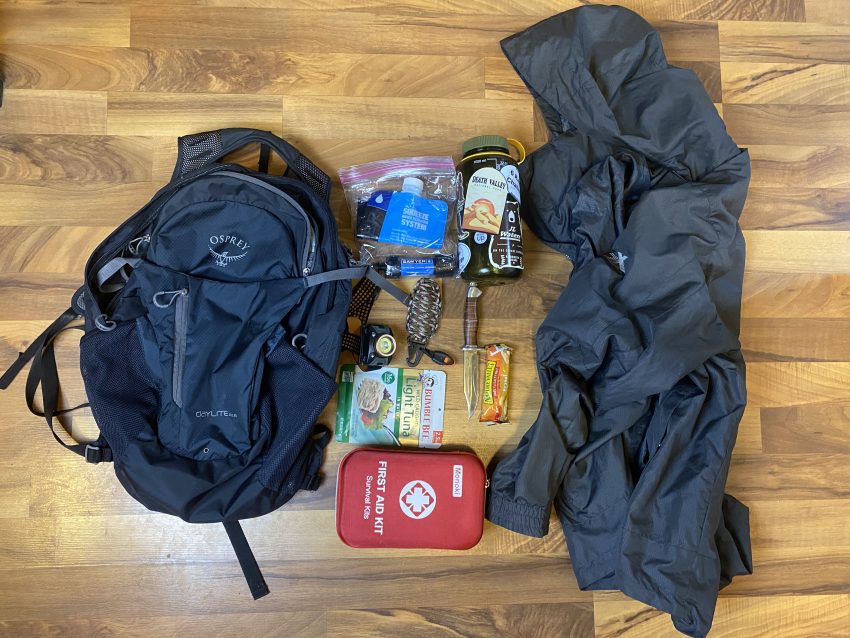A day hike is considered a hike you can finish in a single day typically under 15 miles. If it involves you stoping to setup camp you are falling into the backpacking category. So what all do you need for a day hike? That will all depend on your terrain, length, and weather.
No matter your hike its always smart to be prepared and confident you have what you need for any type of emergency situation.
The Items Below should be included on your day hikes.
- Day Hiking Pack
- Weather-appropriate clothing
- Footwear
- Adequate amount of water
- Adequate amount of food
- Navigation
- First-aid kit
- Multi-tool
Day Hiking Pack
Your day hiking pack should be around 20-35 liters. Any bigger than that, you are creeping into backpacking which is not what we are covering today. A day pack under 35 liters will fit all of your day hiking essentials, including extra food and water if needed. Keeping your day pack light is going to make the day hike more enjoyable instead of lugging useless gear around. A couple day hiking brands to consider are Osprey, Deuter, and REI Flash. All of these make great bags and are comfortable.
Weather-appropriate clothing
Weather conditions are going to affect the different types of clothing you will need to wear. Clothing that is more versatile would be a moisture wicking fabric such as polyester. Merino Wool is another great option for colder days. When it’s colder, wear more layers and shed those layers as you warm up to avoid sweating and chills. For the warmer months wear light breathable layers to keep you cool. Weather can be so unpredictable so always pack a rain jacket or poncho.
Footwear
No matter whether you prefer boots or trail runners, having the correct shoes is super important. Having a solid shoe that is designed for the type of terrain you are hiking is critical. You don’t want to be 5 miles into the wilderness with basketball shoes while your feet are killing you with bruises or blisters and chance getting stuck out there.
Taking care of your feet is more than just your shoes. Consider your type of socks as well. Having hiking socks will also help contribute to preventing blisters and sweaty feet. Sock brands to check out would be Darn Tough, Smartwool, and Wigwam. You can read more on the best hiking socks here.
Water
Water is the most important resource. As soon as you run out of water you run the risk of getting dehydrated. When you are miles and miles from your ending point this could spell trouble. Men need 3.7 liters a day or water and Women need 2.7 liters a day. Use those measurements as starting points to plan for your hike. Typically its a smart idea to carry more water than you need just in case. Personally, I’ll carry a 2 liter bladder and/or a liter bottle of water. For more information on staying hydrated read more here.
Food
Right behind water, food is an important energy source you should not skimp on. Packing a simple trail mix is fine, but should accoutn for just a small portion of your food source. Protein bars, dried fruits, and beef jerky are all light packaged food that do not need to be prepared. Always carry enough food for a full second day in case of an emergency situation.
Navigation
Having proper navigation and being able to read those navigation tools such as a map or compass can get you out of a sticky situation quickly. Technology these days has allowed for GPS apps on your phones such as the All-Trails app that allow you to navigate with no cell service. However, what if your phone battery dies or you fall and break your phone? Having and knowing how to use a paper map and compass is always a good idea and should always be carried.
First Aid Kit
Always be prepared for any situation. Insect bites, a broken arm or leg, and even getting lost and having to spend a night in the forest. Having a proper first-aid kit will go a long way. First aid kits should, at minimum, include bandages, ointments/creams, pain relievers, and tweezers.
Multi-Tool
A knife or multi-tool with a knife in it is a great item to have in any emergency situation. A knife can help with preparing limbs for a fire or shelter and also defending yourself.
Extras
Some extra gear that has not been listed above would be a headlamp with at least 200 lumens. That hike may take longer than you expect and a hike back in the dark can be disastrous, so having a reliable headlamp would be a necessity.
An emergency shelter/bivy is another piece of gear that should live in your pack. There are many lightweight emergency shelter bivys out there, find one that will fit your needs.
In an emergency situation, fire can make things easier. Such as sanitizing water, cooking food, and lifting spirits so adding quick packaged fire starters that are waterproof to your pack should be a must. More information on the best firestarters read more here.
No matter how long your hike is always be prepared. Things happen and a bad situation can get worse if not properly prepared. While this list will not suit everyone’s needs please use it as a guide and adjust to your hiking needs.
